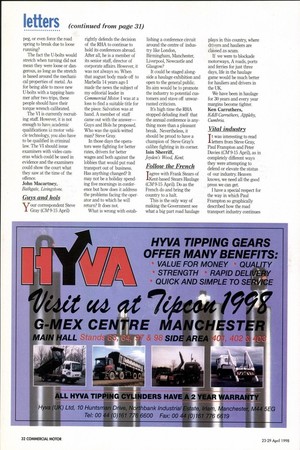Loose nuts Jam writing regarding an article in CM Legal News, 18-31 December 1997.
Page 29

Page 30

If you've noticed an error in this article please click here to report it so we can fix it.
Reading various articles published in CM over the past few months, the Vehicle Inspectorate appears to be coming under fire regarding the way it carries out roadside inspections and the subsequent issue of prohibitions.
The articles seem to show the vehicle examiners as over-zealous, issuing PG9s for minor defects. However, when you read the article "Opinions differ over Ubolts" you begin to wonder if this criticism is fair. Who are the critics who write in about these unfair decisions? Are they irate hauliers who keep getting caught for various offences, or is it a case that the criticism is fair and indeed the VI needs to look at its procedures more closely? I will not comment on this but would like to discuss the U-bolt article. Obviously anybody reading the report cannot know the full facts of this case. However, this is my interpretation of the events that day.
The vehicle was examined in a spot check, the U-bolts were found to be loose by the usual method used by the VI, "the tapping hammer". The inspector could see that there had been movement of the axle in relation to the road spring and the U-bolts moved when hit with the tapping hammer. He decided to issue a prohibition.
In the workshops where I am employed, land my colleagues use the same method when carrying out safety inspections and would have reached the same conclusion as the VI, that the U-bolts were loose. If the vehicle or trailer was going for annual test and no action was taken I would expect a failure.
The article states that Rusden was a qualified fitter. He was also a wise operator who has noticed that a good defence can get results under certain circumstances.
He employed John Backhouse and consultant engineer Ivan Sanderson to defend him. The inspector from the VI stated that the vehicle was in a dangerous condition, but allowed it to move at a slow speed by varying the prohibition. The result was to allow the defence to argue that the vehicle could not have been in a dangerous condition as it was allowed to move on the highway.
Sanderson stated he could not tighten the nuts, although when struck with a hammer there was some movement. In his opinion it was not in any way dangerous. He said there was no possibility of the spring becoming displaced. He stated that even with a new Ubolt he could obtain movement after two journeys if he hit it with a hammer.
I ask myself if there are lessons to be learned from this case.
a) Any prohibition issued for vehicles in a dangerous condition should not be varied or the prosecution will throw the case out.
b) Will the tapping hammer used by the VI and workshops throughout the country be discarded and every nut and bolt be checked by a spanner?
c) Out go visual inspections.
d) I will advise my staff not to worry about movement found in relation to spring/ axle seats, as this is due to the elastic tendency of the Ubolt.
e) If movement seems to be present and U-bolts appear loose and cannot be tightened, don't replace them. The nuts are not seized. It is once again due to the elastic tendency of the U-bolt I take my hat off to Mr Rusden, who was so worried by the prohibition being immediately dangerous that he called in a consultant engineer. There was no possibility the spring could become displaced by the very nature of its design. However, if it was indeed loose, could this not shear the centre bolt or locating peg, or even force the road spring to break due to loose running?
The fact the U-bolts would stretch when turning did not mean they were loose or dangerous, as long as the stretch is based around the mechanical properties of metal. As for being able to move new U-bolts with a tapping hammer after two trips, these people should have their torque wrench calibrated.
The VI is currently recruiting staff. However, it is not enough to have academic qualifications iA motor vehicle technology, you also have to be qualified in criminal law. The VI should issue examiners with video cameras which could be used in evidence and the examiners could show the court what they saw at the time of the offence.
John Macartney, . Bathgate, Livingstone










































































































